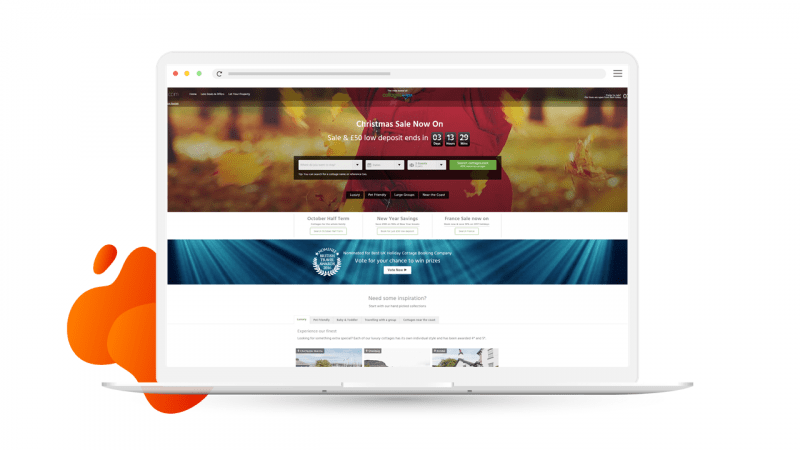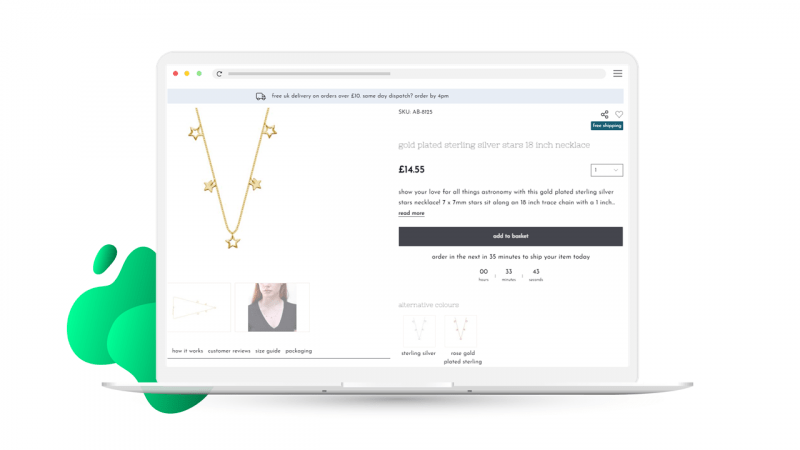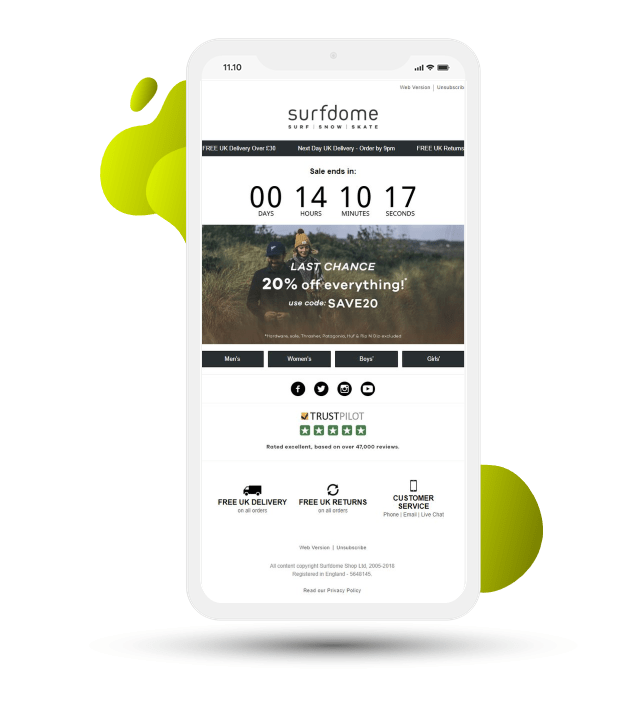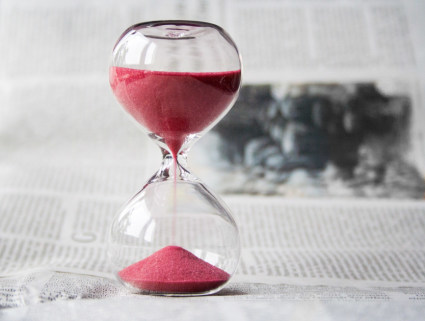Promotional countdown timers are an easy-to-implement way to increase click throughs and generate a buzz around your latest offers.
Marketers are able to drive engagement with dynamic countdown timers that update in real-time across websites and email channels.
See how Apple Mail users’ real-time emails may be affected: Apple Mail privacy updates: Implications for online businesses and Fresh Relevance’s approach.
Countdown timers can be used to draw attention to limited-duration sales, encourage participation in events, inform customers of your opening hours, and more.
As with any promotional content, it’s important to make the customer experience the number one priority when using them.
According to the Advertising Standards Authority (ASA), there are five best practices you need to keep in mind to provide customers with an authentic experience:
- A countdown timer shouldn’t be restarted after it reaches zero.
- Prices should not remain the same or get lower than the promotional period price.
- If you make delivery time claims, you need evidence to show that you reach that target on a consistent basis.
- Do not apply undue pressure on audiences to gamble, or create an unjustifiable sense of urgency.
- If you run a promotion with a prize, ensure that it’s clear from the start how and by when a winner needs to respond to claim it.
We’ve compiled some tips and inspiring examples to help you make the best use of countdown timers, while maintaining the integrity of your brand.
Our 4 top tips
1. Keep it genuine
Remaining honest in the use and application of a countdown timer is critical to its effectiveness.
It might be tempting to create a fake deadline to boost short-term sales but doing so risks the integrity of your brand and you could lose customers for good. Setting clear parameters around limited time offers and ensuring promotions close as advertised will help retain customer trust in the brand.
In the example below, Cottages.com uses a countdown timer to display the cut-off date of an offer. This is especially effective as research has shown that more than 1 in 4 consumers (28%) say they want retailers to highlight important order cut-off dates.

FFX combines their sale’s countdown timer with a personalized coupon in their email below. This is especially effective when you send these types of emails to the right segment of customers, based on the behavioral data you collect.

2. Less is more
Marketers should also be mindful of how often they use countdown clocks within their campaigns.
Incorporating timers too often could mean the excitement driven by the tactic is lost. Part of the role of a timer is to inject urgency, but if customers are presented with a countdown clock each time they open an email, it will quickly be ignored and fail to deliver the intended call to action.
On this occasion, less is more. Identifying when and where a countdown timer will have a significant role in boosting sales will help keep customers engaged – whether that’s to mark a significant day in the retail calendar or to create a buzz around a new product launch.
For example, Molton Brown generates excitement around their new product launch on their website, as shown below.

Another effective way to use countdown timers in email marketing is to try and bring back lapsed customers, as Space NK do in the example below.

3. Stay relevant
As with other real-time marketing tactics, it’s important to deliver content that is relevant at the moment of engagement, both during and after the end of the promotion. This can be achieved by defining different creatives for different scenarios.
If shoppers engage with the email or website during the promotion, they’ll see the timer. Once the countdown clock reaches zero, shoppers should see a different creative, for example a banner promoting another offer.
Looking for unique instances where other brands might not be using timers will also bring some differentiation to a brand. Flash sales or shopping peaks like Black Friday have an obvious role for countdown clocks. But brands could also consider adding a countdown to provide service information, for example to make shoppers aware of how long they have left to complete an order to receive the product the next day.
In the example below, Jewellerybox make use of a non-intrusive countdown timer to remind shoppers to purchase before a certain time to guarantee quick delivery. This increases urgency, which in turn increases the likelihood of a shopper making a purchase. Since implementing the countdown timer they’ve seen a 5% increase in conversion rates in the two hours prior to the same day shipping cut off.

Lloyd’s Pharmacy do the same in their cart abandonment emails in the example below.

Leveraging behavioral triggers to send countdown timers via email is also a effective ecommerce personalization tactic, using cart abandonment as a trigger for example. Travel brand Awaze are seeing a close to 40% increase in conversion rate using dynamic countdown timers in email campaigns.
We found that more than 1 in 3 (34%) of consumers want retailers to highlight spending thresholds that unlock an incentive. By using countdown timers counting down until the moment customers have until next-day delivery and combining it with product recommendations that are in the price range to reach the free delivery threshold, you are likely to increase average order value.
Read more about pricing strategies like the one mentioned above: FreshPro: 7 tips to optimize your eCommerce pricing strategy.
4. Don’t interrupt
The physical location and design of a timer are other key considerations that will impact effectiveness. Keep in mind that the ultimate aim of the tactic is to encourage a purchase, so its execution must avoid interrupting the customer journey as much as possible.
Triggering a website banner with a timer promoting a relevant offer will be more effective if the customer has had the opportunity to view a couple of web pages rather than displaying it as soon as the shopper lands on your website. Alternatively, displaying a limited time offer for free delivery when a customer has added an item to their basket could be the incentive to secure the sale.
From an aesthetics perspective, timers should be visually appealing and eye-catching – after all, they are meant to signify something exciting to the consumer. The design should harmonize with the overall look and feel of the brand.
In the example below, LSE Retail’s Iconic Lights website uses a sleek, on-brand countdown timer at the top of the page. This is non-invasive but still catches their customers’ attention.
![]()
In our final example below, Surfdome uses email to promote their sale. Together with a countdown timer and a coupon code, the company creates a sense of trust with their customers by using the star ratings provided by Trustpilot.

Ready to count down to uplifted sales?
We can help you create your own cross-channel countdown timers, as well as all the other features mentioned above – and more.
Request a demo with us today and download the Dynamic Content Playbook to discover more types of dynamic content you can easily add to your website and emails to boost your conversion rate.







